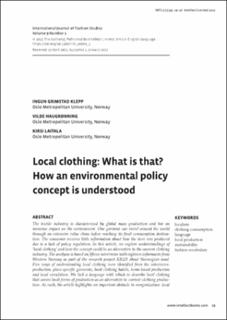| dc.contributor.author | Klepp, Ingun Grimstad | |
| dc.contributor.author | Haugrønning, Vilde | |
| dc.contributor.author | Laitala, Kirsi | |
| dc.coverage.spatial | Norway | en_US |
| dc.date.accessioned | 2022-08-19T12:24:05Z | |
| dc.date.available | 2022-08-19T12:24:05Z | |
| dc.date.created | 2022-04-30T08:43:06Z | |
| dc.date.issued | 2022-04-01 | |
| dc.identifier.citation | International Journal of Fashion Studies (INFS). 2022, 9 (1), 29-46. | en_US |
| dc.identifier.issn | 2051-7106 | |
| dc.identifier.issn | 2051-7114 | |
| dc.identifier.uri | https://hdl.handle.net/11250/3012710 | |
| dc.description.abstract | The textile industry is characterized by global mass production and has an immense impact on the environment. One garment can travel around the world through an extensive value chain before reaching its final consumption destination. The consumer receives little information about how the item was produced due to a lack of policy regulation. In this article, we explore understandings of ‘local clothing’ and how the concept could be an alternative to the current clothing industry. The analysis is based on fifteen interviews with eighteen informants from Western Norway as part of the research project KRUS about Norwegian wool. Five ways of understanding local clothing were identified from the interviews: production, place-specific garments, local clothing habits, home-based production and local circulation. We lack a language with which to describe local clothing that covers local forms of production as an alternative to current clothing production. As such, the article highlights an important obstacle to reorganization: local clothing needs a vocabulary among the public, in politics and in the public sector in general, with which to describe the diverse production processes behind clothing and textiles and their material properties. | en_US |
| dc.description.sponsorship | The article was funded by the Research Council of Norway (grant number 319396) in the research project ‘#Amazing grazing – sustainable food and fibre from Norwegian sheep rangeland grazing systems, based on material collected during the KRUS project: Enhancing local wool value chains in Norway’. | en_US |
| dc.language.iso | eng | en_US |
| dc.publisher | Intellect | en_US |
| dc.relation.ispartofseries | International Journal of Fashion Studies (INFS);Volume 9, Number 1 | |
| dc.relation.uri | https://www.ingentaconnect.com/contentone/intellect/infs/2022/00000009/00000001/art00003 | |
| dc.rights | Attribution-NonCommercial-NoDerivatives 4.0 Internasjonal | * |
| dc.rights.uri | http://creativecommons.org/licenses/by-nc-nd/4.0/deed.no | * |
| dc.subject | Localism | en_US |
| dc.subject | Clothing consumption | en_US |
| dc.subject | Language | en_US |
| dc.subject | Local production | en_US |
| dc.subject | Sustainability | en_US |
| dc.subject | Fashion vocabulary | en_US |
| dc.title | Local clothing: What is that? How an environmental policy concept is understood | en_US |
| dc.type | Peer reviewed | en_US |
| dc.type | Journal article | en_US |
| dc.description.version | publishedVersion | en_US |
| dc.rights.holder | © 2022 The Author(s) | en_US |
| cristin.ispublished | true | |
| cristin.fulltext | original | |
| cristin.qualitycode | 1 | |
| dc.identifier.doi | https://doi.org/10.1386/infs_00060_1 | |
| dc.identifier.cristin | 2020272 | |
| dc.source.journal | International Journal of Fashion Studies (INFS) | en_US |
| dc.source.volume | 9 | en_US |
| dc.source.issue | 1 | en_US |
| dc.source.pagenumber | 29-46 | en_US |
| dc.relation.project | Norges forskningsråd: 319396 | en_US |

